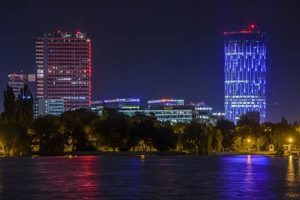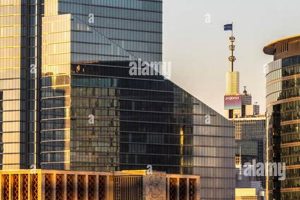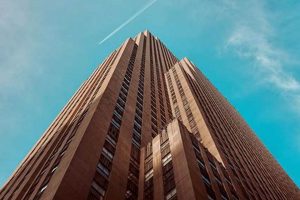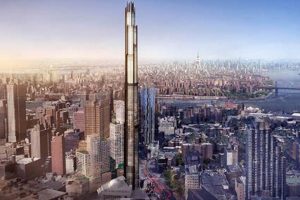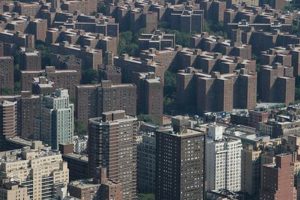A skyscraper is a continuously habitable high-rise building that has over 40 stories and is at least 150 meters (492 feet) tall. Skyscrapers are often used for commercial purposes, such as offices, hotels, and retail stores, but can also be used for residential purposes. The world’s tallest skyscraper is the Burj Khalifa in Dubai, which has 163 stories and is 828 meters (2,717 feet) tall.
Skyscrapers are important because they allow for the efficient use of land in urban areas. By building up instead of out, skyscrapers can help to reduce traffic congestion and pollution. Skyscrapers can also be iconic landmarks that define a city’s skyline. The Empire State Building in New York City and the Sears Tower in Chicago are two examples of skyscrapers that have become symbols of their respective cities.
The history of skyscrapers can be traced back to the late 19th century, when the invention of the elevator made it possible to build tall buildings. The first skyscraper was the Home Insurance Building in Chicago, which was completed in 1885 and had 10 stories. Since then, skyscrapers have become increasingly common in major cities around the world.
1. Height
Height plays a defining role in the concept of a skyscraper. These towering structures ascend to remarkable elevations, often exceeding 150 meters (492 feet) and reaching over 100 stories. This vertical dimension distinguishes skyscrapers from other buildings and contributes to their iconic status.
- Structural Innovations: Achieving such heights requires innovative engineering solutions. Skyscrapers employ reinforced concrete, steel frames, and advanced materials to withstand wind forces and seismic activity.
- Urban Density: Height allows skyscrapers to maximize land utilization in densely populated urban areas. By building upwards, cities can accommodate more people and businesses without expanding outwards.
- Landmark Status: The extraordinary height of skyscrapers often makes them landmarks that define city skylines. Buildings like the Empire State Building and the Petronas Towers have become symbols of their respective cities.
- Elevators and Transportation: Efficient vertical transportation systems, such as high-speed elevators and sky lobbies, are crucial for navigating tall skyscrapers. These systems enable occupants to move quickly and conveniently between floors.
In essence, the height of skyscrapers is not merely a physical attribute but a combination of architectural prowess, urban planning, and engineering ingenuity. It is an integral part of the skyscraper definition, shaping their functionality, aesthetics, and impact on the urban landscape.
2. Stories
The concept of “stories” is deeply intertwined with the definition of a skyscraper. A skyscraper’s status as a “multi-levelled edifice with numerous floor divisions” highlights several key aspects:
- Vertical Space Utilization: Dividing a skyscraper into multiple stories allows for efficient use of vertical space. It increases the building’s capacity to accommodate various functions and occupants.
- Functional Diversity: Each story can be designed to serve a specific purpose, creating a vertical ecosystem within the building. For example, lower stories may house retail spaces, while upper stories are dedicated to offices or residential units.
- Height Attainment: The accumulation of numerous stories contributes to the overall height of a skyscraper. The number of stories is directly related to the building’s height, making it a defining characteristic.
- Tenant Mix: Multiple stories enable skyscrapers to accommodate a diverse mix of tenants, creating a vibrant and dynamic environment. This diversity can include businesses, residential units, and public amenities.
- Elevator Systems: The presence of multiple stories necessitates efficient vertical transportation systems. Elevators and sky lobbies play a crucial role in ensuring convenient movement of occupants throughout the building.
In summary, the “stories” component of a skyscraper definition emphasizes the building’s verticality, functional diversity, height attainment, tenant mix, and reliance on elevator systems. Understanding this connection provides insights into the design, construction, and utilization of skyscrapers as multi-dimensional urban spaces.
3. Urban Density
The connection between “Urban Density: Efficient utilization of land space in metropolitan areas” and “skyscraper definition” lies at the heart of skyscraper development and urban planning. Skyscrapers emerged as a direct response to the increasing demand for space in densely populated urban areas. By building upwards instead of outwards, cities can accommodate more people and businesses without expanding their physical boundaries.
Skyscrapers offer a number of advantages in terms of urban density. First, they allow for a more efficient use of land, which is a scarce resource in metropolitan areas. By concentrating development vertically, cities can preserve valuable green spaces and reduce urban sprawl. Second, skyscrapers can help to reduce traffic congestion and pollution by encouraging people to live and work in closer proximity to each other. Third, they can create more vibrant and walkable neighborhoods by bringing together a mix of residential, commercial, and public spaces.
Real-life examples of cities that have successfully utilized skyscrapers to increase urban density include New York City, Tokyo, and Hong Kong. In New York City, for example, skyscrapers have played a major role in the development of the city’s iconic skyline and have helped to create a densely populated and vibrant urban environment. Similarly, in Tokyo, skyscrapers have been used to create a compact and efficient city that is home to over 13 million people. And in Hong Kong, skyscrapers have helped to transform the city into a global financial center and one of the most densely populated urban areas in the world.
Understanding the connection between urban density and skyscraper definition is essential for urban planners and architects. By designing and constructing skyscrapers that are sensitive to the surrounding urban environment, cities can create more sustainable, livable, and prosperous communities.
4. Commercial Hubs
Skyscrapers have become synonymous with com
mercial activity, serving as hubs for businesses, retail, and hospitality industries. This connection is deeply rooted in the skyscraper definition, as these buildings are designed to accommodate a wide range of commercial functions.
- Office Spaces: Skyscrapers provide vast amounts of office space, catering to businesses of all sizes. The height and multi-story nature of skyscrapers allow for efficient use of space, accommodating large numbers of employees within a single building.
- Retail and Shopping: Many skyscrapers incorporate retail spaces on lower floors or in podiums. These spaces attract shoppers and contribute to the vibrancy of the surrounding urban environment. Skyscrapers can create unique shopping experiences, often featuring high-end boutiques and luxury brands.
- Hospitality and Tourism: Skyscrapers often house hotels, restaurants, and other hospitality amenities. These facilities cater to business travelers, tourists, and local residents, adding to the building’s functionality and appeal.
- Mixed-Use Developments: Modern skyscrapers often adopt a mixed-use approach, combining commercial, residential, and sometimes even cultural or recreational facilities within a single structure. This approach creates a dynamic and self-contained environment that supports a variety of activities.
The integration of commercial hubs within skyscrapers has several advantages. It allows for a more efficient use of urban space, reduces commuting times, and creates vibrant and walkable neighborhoods. Skyscrapers serve as centers of economic activity, attracting businesses and professionals from various industries. By accommodating a mix of commercial uses, skyscrapers contribute to the overall vitality and prosperity of the urban environment.
5. Architectural Marvels
Skyscrapers have become symbols of architectural ingenuity and urban pride, transforming skylines and reshaping the identity of cities. Their status as “architectural marvels” is deeply intertwined with the very definition of a skyscraper, highlighting several key aspects:
- Engineering Innovations: Skyscrapers push the boundaries of architectural and engineering design. They employ advanced construction techniques, innovative materials, and cutting-edge technologies to achieve unprecedented heights and structural stability.
- Unique Designs: Each skyscraper is a unique work of art, showcasing distinctive architectural styles and design elements. They incorporate various shapes, facades, and lighting systems to create visually stunning landmarks that define cityscapes.
- Cultural Significance: Skyscrapers often embody the cultural identity and aspirations of the cities they inhabit. They serve as symbols of economic power, technological advancement, and national pride.
- Tourist Attractions: Many skyscrapers are renowned tourist destinations, attracting visitors from around the world. Observation decks, rooftop restaurants, and architectural tours offer breathtaking views and insights into the engineering and design of these iconic structures.
In essence, skyscrapers are not merely functional buildings but also works of architectural art that shape the character and identity of cities. Their iconic status stems from their innovative designs, engineering marvels, cultural significance, and appeal as tourist attractions. Understanding this connection provides a deeper appreciation for the role of skyscrapers in shaping the urban landscape and enriching the human experience.
6. Engineering Feats
The phrase “Engineering Feats: Innovations in Construction and Infrastructure” captures the essence of what sets skyscrapers apart from other buildings. Skyscrapers are not merely tall structures but marvels of engineering that push the boundaries of construction and infrastructure.
- Structural Innovations: Skyscrapers employ advanced structural systems, such as reinforced concrete, steel frames, and diagrid designs, to withstand immense weight and lateral forces. These innovations allow skyscrapers to reach unprecedented heights while maintaining structural integrity.
- Wind Engineering: Skyscrapers are subjected to strong wind forces due to their height. To mitigate these forces, engineers use wind tunnels and computer simulations to design aerodynamic shapes and incorporate wind-damping systems.
- Foundation Engineering: The foundation of a skyscraper must be strong enough to support the massive weight of the structure. Engineers employ deep foundations, such as piles and caissons, to transfer the load deep into the ground.
- Vertical Transportation: Efficient vertical transportation is crucial in skyscrapers. Engineers design high-speed elevators, sky lobbies, and other systems to move people and goods quickly and efficiently.
These engineering feats are not just about achieving height but also about ensuring safety, functionality, and sustainability. Skyscrapers are designed to withstand earthquakes, fires, and other extreme events, providing safe and habitable spaces for occupants.
7. Vertical Communities
The concept of “Vertical Communities: Self-contained environments with residential and social amenities” is deeply intertwined with the “skyscraper definition.” Skyscrapers, by their inherent nature of reaching great heights and accommodating numerous occupants, often incorporate residential units and various social amenities within their structures, creating self-contained vertical communities.
This integration of residential and social amenities within skyscrapers offers several advantages. First, it fosters a sense of community and belonging among residents. Shared spaces, such as communal lounges, fitness centers, and rooftop gardens, provide opportunities for social interaction and community building. Second, vertical communities promote convenience and efficiency. Residents have direct access to essential services and amenities within the building, reducing the need for external travel. Third, skyscrapers can contribute to urban sustainability by reducing traffic congestion and promoting walkability, as residents can access many of their daily needs within the building or within close proximity.
Real-life examples of skyscrapers that exemplify the concept of vertical communities include the Burj Khalifa in Dubai, which houses residential units, offices, and a luxury hotel; the One World Trade Center in New York City, which includes residential apartments, retail spaces, and a performing arts center; and the Shanghai Tower in China, which features residential apartments, offices, a hotel, and a shopping mall. These skyscrapers are not just tall buildings but thriving vertical communities that offer a unique blend of living, working, and leisure experiences.
Understanding the connection between “Vertical Communities: Self-contained environments with residential and social amenities” and “skyscraper definition” is crucial for architects, urban planners, and policymakers. By incorpora
ting residential and social amenities into skyscrapers, cities can maximize land use, promote sustainable living, and enhance the overall quality of life for residents. Vertical communities offer a glimpse into the future of urban living, where skyscrapers are not just symbols of architectural prowess but vibrant and self-sufficient microcosms within the larger urban fabric.
FAQs on Skyscraper Definition
This section addresses frequently asked questions (FAQs) related to the definition and characteristics of skyscrapers, providing concise and informative answers.
Question 1: What is the defining characteristic of a skyscraper?
Skyscrapers are continuously habitable high-rise buildings that typically exceed 40 stories and 150 meters (492 feet) in height.
Question 2: What is the purpose of building skyscrapers?
Skyscrapers serve various purposes, including commercial (offices, retail stores), residential (apartments, condominiums), and mixed-use developments that combine commercial and residential spaces.
Question 3: What are the engineering challenges in constructing skyscrapers?
Skyscrapers require innovative engineering solutions to withstand strong winds, seismic forces, and gravitational loads. These solutions include advanced structural systems, wind-damping technologies, and deep foundations.
Question 4: How do skyscrapers contribute to urban development?
Skyscrapers promote efficient land use in densely populated urban areas, reducing urban sprawl and preserving green spaces. They also create vertical communities with integrated residential, commercial, and social amenities, enhancing convenience and walkability.
Question 5: What are some iconic examples of skyscrapers?
Famous skyscrapers include the Burj Khalifa (Dubai), One World Trade Center (New York City), Shanghai Tower (China), and Taipei 101 (Taiwan), each showcasing unique architectural designs and engineering feats.
Question 6: How are skyscrapers adapting to sustainability concerns?
Modern skyscrapers incorporate sustainable design features such as energy-efficient lighting systems, rainwater harvesting, and green roofs to reduce their environmental impact.
Understanding these FAQs provides a deeper insight into the definition, purpose, and significance of skyscrapers in the modern urban landscape.
Transition to the next article section:
Tips for Understanding Skyscraper Definitions
Comprehending the definition of a skyscraper involves several key considerations:
Tip 1: Height and Stories: Skyscrapers are characterized by their exceptional height, typically exceeding 40 stories and 150 meters (492 feet). This vertical dimension distinguishes them from other high-rise buildings.
Tip 2: Urban Density: Skyscrapers play a crucial role in maximizing land utilization in densely populated urban areas. By building upwards, cities can accommodate more people and businesses without sprawling outwards.
Tip 3: Commercial Hubs: Skyscrapers often serve as centers for commercial activities, housing offices, retail stores, and hospitality amenities. This concentration of businesses contributes to economic growth and vitality.
Tip 4: Architectural Marvels: Skyscrapers are not merely functional structures but also architectural wonders. Their unique designs and engineering innovations make them iconic landmarks that define city skylines.
Tip 5: Vertical Communities: Modern skyscrapers often incorporate residential units and social amenities, creating self-contained vertical communities. This integration promotes a sense of community and convenience.
Tip 6: Engineering Feats: Constructing skyscrapers requires advanced engineering solutions to withstand wind forces, seismic activity, and gravitational loads. These solutions include reinforced concrete, steel frames, and deep foundations.
Tip 7: Sustainability: Contemporary skyscrapers prioritize sustainable design features such as energy efficiency, rainwater harvesting, and green roofs to minimize their environmental impact.
Tip 8: Cultural Significance: Skyscrapers often embody the cultural identity and aspirations of the cities they inhabit, becoming symbols of economic power and technological advancement.
By considering these tips, individuals can gain a deeper understanding of skyscraper definitions and their significance in urban development and architectural history.
Transition to the conclusion of the article:
Skyscraper Definition
In conclusion, the definition of a skyscraper encompasses more than just its physical attributes of height and stories. Skyscrapers represent architectural marvels that push the boundaries of engineering and design. They serve as vertical communities, providing self-contained environments with residential and social amenities. As hubs for commercial activity, they contribute to economic growth and vitality. Furthermore, skyscrapers often embody the cultural identity and aspirations of cities, becoming iconic landmarks that define skylines.
As cities continue to grow and evolve, skyscrapers will undoubtedly play a pivotal role in shaping the future of urban development. Their efficient use of land, promotion of vertical communities, and integration of sustainable design principles make them essential components of modern urban landscapes. Understanding the multifaceted definition of a skyscraper is crucial for architects, urban planners, and anyone interested in the built environment. By embracing the unique characteristics and benefits of skyscrapers, we can create vibrant, sustainable, and awe-inspiring cities for generations to come.


